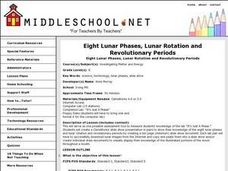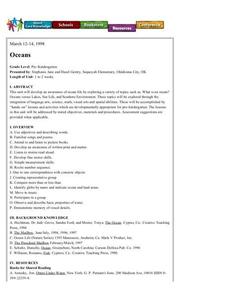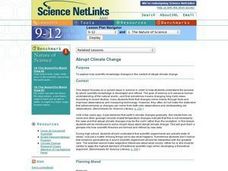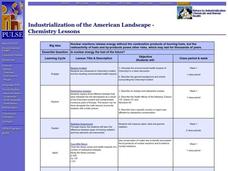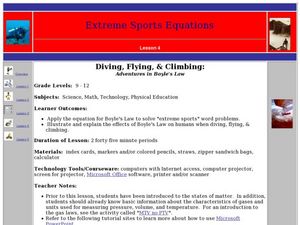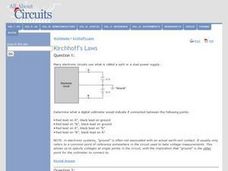Curated OER
A Fraction of the Possibilities
Students review the conversion of fractions to decimals, develop strategies to compare fractions perform complex calculations using ratio techniques similar to the construction of fractions.
Curated OER
Eight Lunar Phases, Lunar Rotation and Revolutionary Periods
Eighth graders create a slide show to show their knowledge of the eight lunar phases and lunar rotation and revolutionary periods.
Curated OER
Building Bridges
Students, in groups, design and test a scale bridge. They use the Internet to research three basic bridge designs -- beam, arch, and suspension -- and the forces that act upon them.
Curated OER
From Bats to Babies: Ultrasound
Students research and analyze sound waves and how an ultrasound works to image a baby in utero. They explore various websites, complete worksheets, and write a paragraph describing a demonstration they view in the classroom.
Curated OER
Oceans
Students become aware of the differences between ocean water and lake water by smelling, tasting and seeing. They distinguish between land and bodies of water on a globe and gain increased awareness of oceans and life.
Curated OER
Growing Barley for Use in Biosynthesis Experiments
Students attempt to determine the optimum growing conditions for barley. They assess the effects of a number of substances such as ammonium chloride and urea on the plants
Curated OER
Going, Going, Gone!
Sixth graders use the scientific method to test variables of evaporation. In this evaporation lesson plan, 6th graders test a wet handprint on a paper towel and relate this experiment to weather conditions.
Curated OER
Rocket Me into Space
Young scholars engage in a activity that reinforces rockets as a vehicle that helps us explore outside the Earth's atmosphere by using the principles of Newton's third law of motion. Also, the principles that engineers deal with when...
Curated OER
Dangerous Air
Students investigate how pollution is a global issue. They locate the countries affected by radiation from Chernobyl, sequence the progress of radiation transport from Chernobyl and plot the pollution points on a world map, and read and...
Curated OER
Properties of Magnetic Forces
Students explore what a magnetic force is and what kinds of objects are attracted to a magnet. They use a magnet to sort objects taht are and are not attracted to a magnet. Students then explain why the objects were or were not...
Curated OER
Numbers in Art
Young scholars choose a number from one to twelve and tell a number story about it. They listen to the teacher read "Numbers in Art" by Lucy Micklethwait. Students choose three numbers from one to twelve and view works of art while...
Curated OER
Abrupt Climate Change
Students explore how scientific knowledge changes in the context of abrupt climate change. They are introduced to some recent ideas about abrupt climate change. This gives them a glimpse into how scientific theories are formed and...
Curated OER
Frosty the Snowman Meets His Demise: An Analogy to Carbon Dating
Learners read and discuss an article about carbon dating, then participate in a hands-on lab to discover how carbon dating works. Students also write a letter to a friend explaining the process, and how archeologists use the process to...
Curated OER
Change It
Fourth graders expand their knowledge about how the physical properties of a substances can be changed. They are given multiple opportunities, using first-hand experiences and familiar objects in different contexts, to identify...
Curated OER
Industrialization of the American Landscape
Students explore the Chernobyl incident and the resulting environmental health impacts. They explore three different isotopes that were released into the atmosphere. Through inquiry, students determine the difference between types of...
Curated OER
Parts of an Ecosystem
Fourth graders study the Great Salt lake and the ecosystem that encompasses it. They study the relationship between an individual of a species, a population of that species, a community that includes that population, and the...
Curated OER
Frog and Toad Are Confusing
Third graders are introduced to the similiarties and differences between a frog and a toad. In groups, they compare and contrast them and identify distinguishing characteristics of each. They watch a video on the animals and answer...
Curated OER
Graphics Integrates Fun
Students take digital pictures of themselves before using a stylus pen on to trace their facial features on a graphic pad. Using an Internet gallery of body drawings they complete a caricature of themselves. In two other activities, they...
Curated OER
Animal Skin
Students investigate the skin surface to body area ratios for different animals. In this seventh/eighth grade mathematics/science lesson, students explore heat transfer between an animal’s body and the environment. Using...
Curated OER
The Mole
In this moles worksheet, students read about mole and learn how to calculate the number of moles in specific mass of compounds. This worksheet has 14 problems to solve.
Curated OER
WS 7.5 Thermodynamics Concepts and Vocabulary
In this thermodynamics worksheet, students fill in the blanks with terms related to specific heat, calorimetry, phase changes, enthalpy, entropy and free energy.
Curated OER
Diving, Flying, & Climbing
Learners explore Boyle's Law. In this Boyle's Law instructional activity, students complete problems involving Boyle's Law. They examine the effects of Boyle's Law upon the human body. Learners use the Internet to complete a lab...
Curated OER
Exercise and Heartrate
Fourth graders experiment to find the effects of exercise on the heart rate. In this exercise and heart rate lesson, 4th graders create questions about exercise and heart rate. Students use the scientific method to test and analyze...
Curated OER
Kirchhoff's Laws
In this circuit worksheet students study electronic circuits and how they get power. Students determine polarity and magnitude and work with Kirchoffs laws to answer 48 questions regarding circuits. Answers are revealed when selected.

